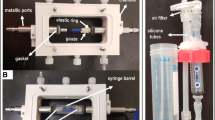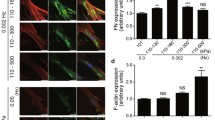Abstract
With the goal of mimicking the mechanical properties of a given native tissue, tissue engineers seek to culture replacement tissues with compositions similar to those of native tissues. In this report, differences between the mechanical properties of engineered arteries and native arteries were correlated with differences in tissue composition. Engineered arteries failed to match the strengths or compliances of native tissues. Lower strengths of engineered arteries resulted partially from inferior organization of collagen, but not from differences in collagen density. Furthermore, ultimate strengths of engineered vessels were significantly reduced by the presence of residual polyglycolic acid polymer fragments, which caused stress concentrations in the vessel wall. Lower compliances of engineered vessels resulted from minimal smooth muscle cell contractility and a lack of organized extracellular elastin. Organization of elastin and collagen in engineered arteries may have been partially hindered by high concentrations of sulfated glycosaminoglycans. Tissue engineers should continue to regulate cell phenotype and promote synthesis of proteins that are known to dominate the mechanical properties of the associated native tissue. However, we should also be aware of the potential negative impacts of polymer fragments and glycosaminoglycans on the mechanical properties of engineered tissues.




Similar content being viewed by others
References
Armentano R. L., Levenson J., Barra J. G., Cabrera Fischer E. I., Breitbart G. J., Pichel R. H., Simon A. (1991) Assessment of elastin and collagen contribution to aortic elasticity in conscious dogs. Am. J. Physiol. 260:H1870–H1877
Bank A. J., Wang. H., Holte J. E., Mullen. K., Shammas. R., Kubo S. H. (1996) Contribution of collagen, elastin, and smooth muscle to in vivo human brachial artery wall stress and elastic modulus. Circulation 94:3263–3270
Bickford W. B. (1993) Mechanics of solids: Concepts and applications. Homewood, IL: Irwin
Brown A. N., Kim B. S., Alsberg E., Mooney D. J. (2000) Combining chondrocytes and smooth muscle cells to engineer hybrid soft tissue constructs. Tissue Eng. 6:297–305
Dahl S. L. M., Koh J., Prabhakar V., Niklason L. E. (2003) Decellularized native and engineered arterial scaffolds for transplantation. Cell Transplant. 12:659–666
Dahl S. L. M., Rucker R. B., Niklason L. E. (2005) Effects of copper and cross-linking on the extracellular matrix of tissue-engineered arteries. Cell Transplant. 14(10):861–868
Debelle L., Tamburro A. M. (1999) Elastin: Molecular description and function. Int. J. Biochem. Cell Biol. 31:261–272
Freed L. E., Vunjak-Novakovic G., Biron R. J., Eagles D. B., Lesnoy D. C., Barlow S. K., Langer R. (1994) Biodegradable polymer scaffolds for tissue engineering. Bio/Technology 12:689–693
Hinek A., Mecham R. P., Keeley. F., Rabinovitch M. (1991) Impaired elastin fiber assembly related to reduced 67-kd elastin-binding protein in fetal lamb ductus arteriosus and in cultured aortic smooth muscle cells treated with chondroitin sulfate. J. Clin. Invest. 88(6):2083–2094
Holzapfel G. A., Gasser T. C. (2000) A new constitutive framework for arterial wall mechanics and a comparative study of material models. J. Elast. 61:1–48
Kim Y. J., Sah R. L., Doong J. Y. H., Grodzinsky A. J. (1988) Fluorometric assay of DNA in cartilage explants using hoechst 33258. Anal. Biochem. 174:168–176
Lanir Y. (1983) Constitutive equations for fibrous connective tissues. J. Biomech. 16(1):1–12
Lemire J. M., Merrilees M. J., Braun K. R., Wight T. N. (2002) Overexpression of the v3 variant of versican alters arterial smooth muscle cell adhesion, migration, and proliferation in vitro. J. Cell Physiol. 190(1):38–45
Merrilees M. J., Tiang K. M., Scott L. (1987) Changes in collagen fibril diameters across artery walls including a correlation with glycosaminoglycan content. Connect. Tissue Res. 16:237–257
Mitchell S. L., Niklason L. E. (2003) Requirements for growing tissue engineered vascular grafts. Cardiovasc. Pathol. 12(2):59–64
Niklason L. E., Gao. J., Abbott W. M., Hirschi. K., Houser. S., Marini. R., Langer R. (1999) Functional arteries grown in vitro. Science 284:489–493
Parry D. A. D., and A. S. Craig. Growth and development of collagen fibrils in connective tissue. In Ultrastructure of the Connective Tissue Matrix, edited by A. Ruggeri and P. M. Motta, Boston: Martinus Nijhoff Pub, pp. 34–64, 1984
Piez, K. A. and R. C. Likins. The nature of collagen. In Calcification in Biological Systems: A Symposium presented at the Washington Meeting of the American Association for the Advancement of Science. December 29, 1958, edited by R. F. Sognnaes. Washington, D.C.: American Association for the Advancement of Science, pp. 411–420, 1960
Prabhakar V., Grinstaff M. W., Alarcon J., Knors C., Solan A. K., Niklason L. E. (2003) Engineering porcine arteries: Effects of scaffold modification. J. Biomed. Mater. Res. 67A:303–311
Sacks M. S. (2003) Incorporation of experimentally-derived fiber orientation into a structural constitutive model for planar tissues. Trans. ASME 125:280–287
Schoeffter P., Muller-Schweinitzer E. (1990) The preservation of functional activity of smooth muscle and endothelium in pig coronary arteries after storage at −190 degrees C. J. Pharm. Pharmacol. 42(9):646–651
Schonherr E., Jarvelainen H. T., Sandell L. J., Wight T. N. (1991) Effects of platelet-derived growth factor and transforming growth factor-beta 1 on the synthesis of a large versican-like chondroitin sulfate proteoglycan by arterial smooth muscle cells. J. Biol. Chem. 266(26):17640–17647
Song Y. C., Hunt C. J., Pegg D. E. (1994) Cryopreservation of the common carotid artery of the rabbit. Cryobiology 31:317–329
Song Y. C., Pegg D. E., Hunt C. J. (1995) Cryopreservation of the common carotid artery of the rabbit: Optimization of dimethyl sulfoxide concentration and cooling rate. Cryobiology 32(5):405–421
Stegemann J. P., Nerem R. M. (2003) Altered response of vascular smooth muscle cells to exogenous biochemical stimulation in two- and three-dimensional culture. Exp. Cell Res. 283(2):146–155
Thyberg J. (1996) Differentiated properties and proliferation of arterial smooth muscle cells in culture. Int. Rev. Cytol. 169:183–265
Wight T. N., Merrilees M. J. (2004) Proteoglycans in atherosclerosis and restenosis: Key roles for versican. Circ. Res. 94(9):1158–1167
Woessner J. F. (1961) The determination of hydroxyproline in tissue and protein samples containing small proportions of this amino acid. Arch. Biochem. Biophys. 93:440–447
Acknowledgments
This work was funded by NIH R-1 HL63766. The authors wish to thank Jay Humphrey for discussions about stress concentrations.
Author information
Authors and Affiliations
Corresponding author
Appendix
Appendix
Calculation of Stress Concentrations Caused by Polymer Fragments
At the suture line, regions of densely packed PGA fragments (e.g., circled area in Fig. 4) were approximated as a single circular stress concentration in the vessel wall. The behavior of this stress concentration during mechanical testing was assumed to be analogous to a void within a plate being pulled in tension.3
To calculate the maximum local stress seen by engineered tissue bordering a polymer “void,” vessel wall thickness, h, and radius of the polymer void, r void, were used to calculate the thickness of the vessel wall not containing polymer, d:
The ratio r void/d was used to calculate a stress concentration factor, K T, which ranged from 2.0 to 3.0:
where σmax was the maximum stress seen by a tissue at a void edge, and σavg was the average stress across d (Fig. 5).
Engineered vessels sense higher stresses near polymer fragments, which act as voids in the tissue, than at tissue sites far away from polymer fragments. σo was the stress seen across the vessel wall when stress distribution was not disrupted by polymer fragments. σavg was the average stress seen across d, the thickness of the vessel wall without the polymer particle. σmax was the maximum stress seen by the tissue at the edge of the polymer or void space. P was the pressure exerted on the vessel lumen.
For a void space covering 15% of the vessel area, r void/d = 0.118, and thus, K T = 2.5.3 With
where r i was the vessel inner radius, and
where length was the axial length of the tested vessel segment, σmax could be calculated from Eq. (A2). The ratio σmax/σo described the factor of increased stress seen by engineered tissue near the polymer void (Table 3). Thus, in the absence of polymer fragments at the suture line and elsewhere, engineered tissues may withstand pressures and stresses greater than 3 times their reported burst pressures and maximum stresses.
Rights and permissions
About this article
Cite this article
Dahl, S.L.M., Rhim, C., Song, Y.C. et al. Mechanical Properties and Compositions of Tissue Engineered and Native Arteries. Ann Biomed Eng 35, 348–355 (2007). https://doi.org/10.1007/s10439-006-9226-1
Received:
Accepted:
Published:
Issue Date:
DOI: https://doi.org/10.1007/s10439-006-9226-1





